Charles E W Bean, Diaries, AWM38 3DRL 606/226/1 - Folder - Part 4
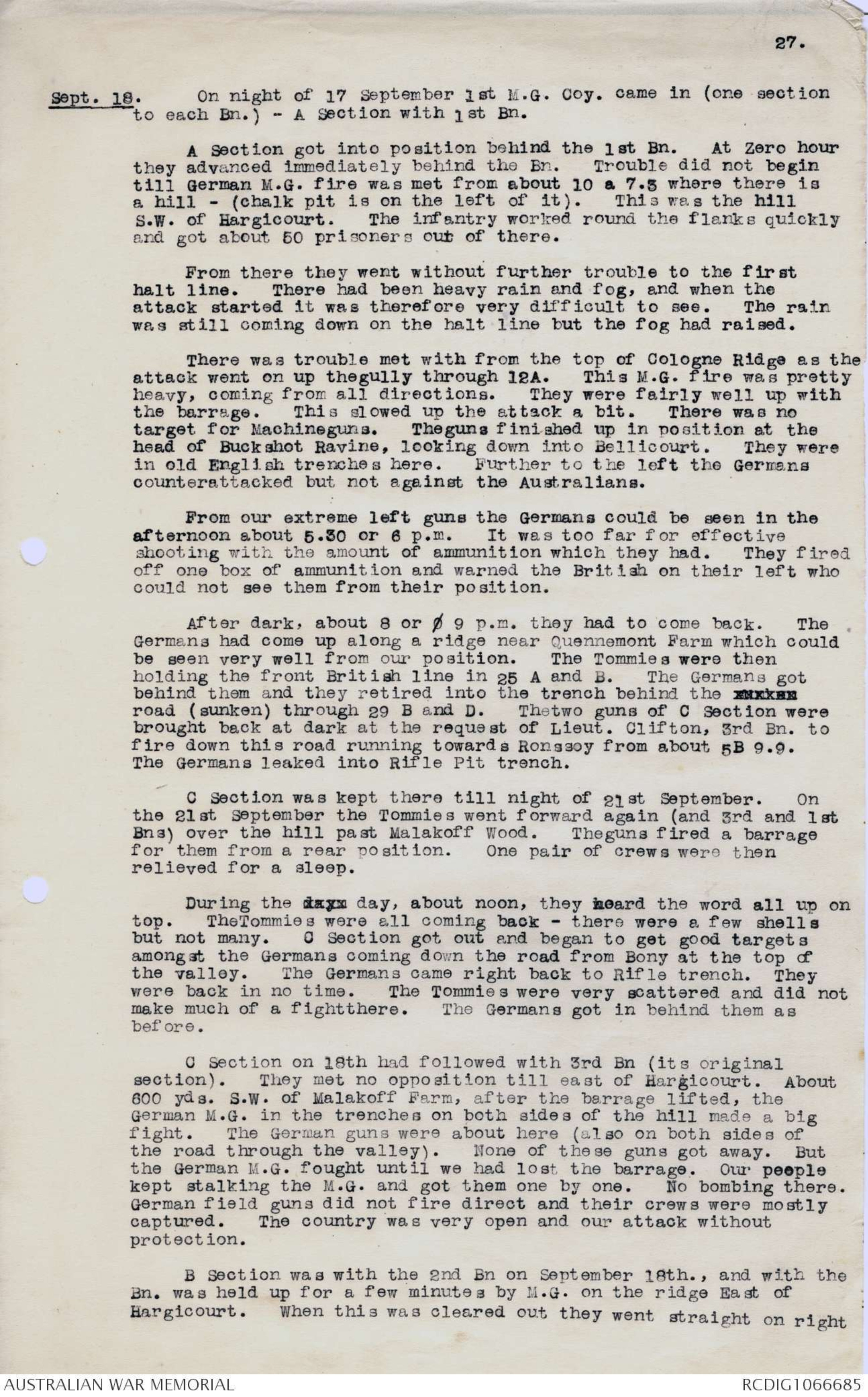
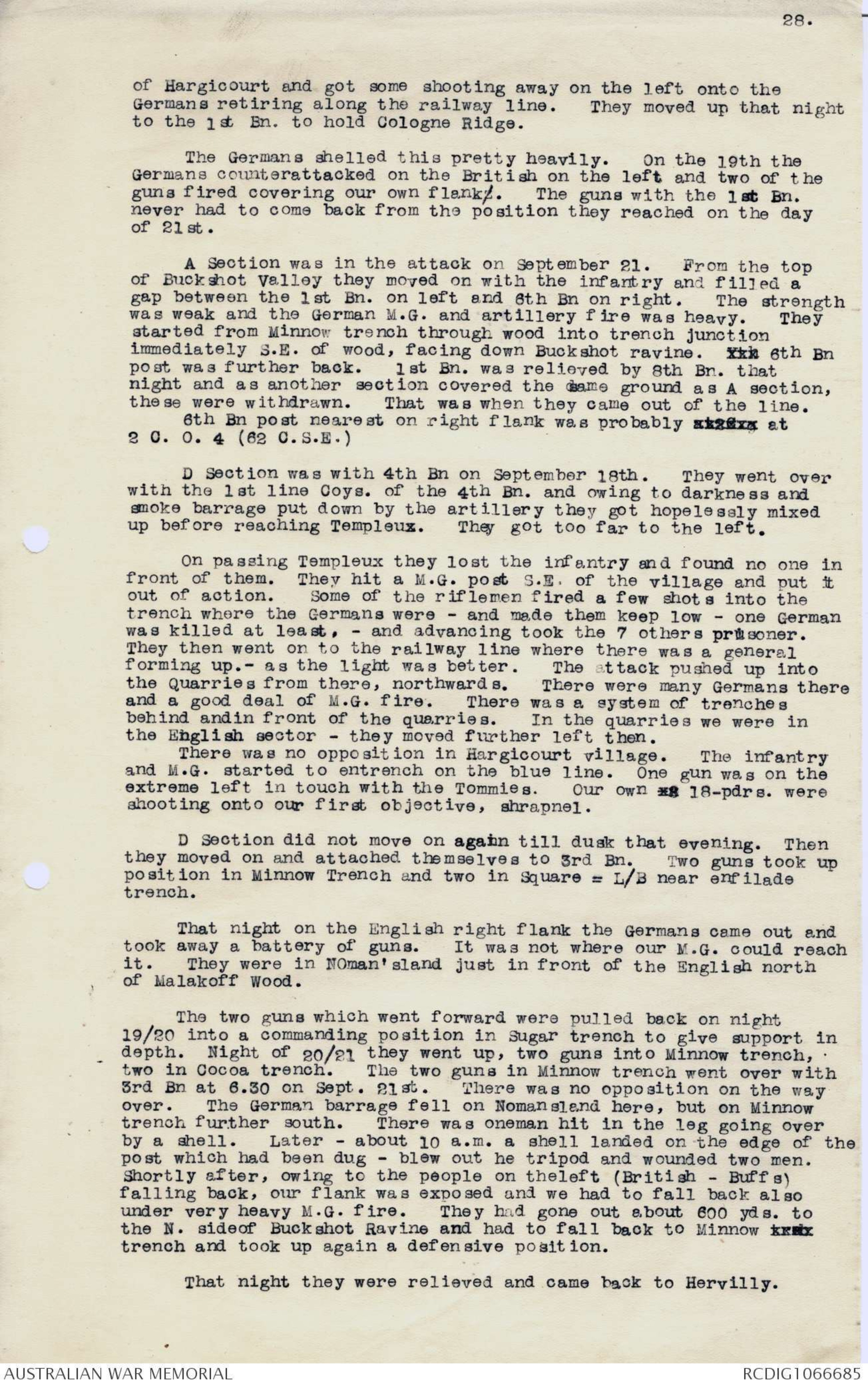
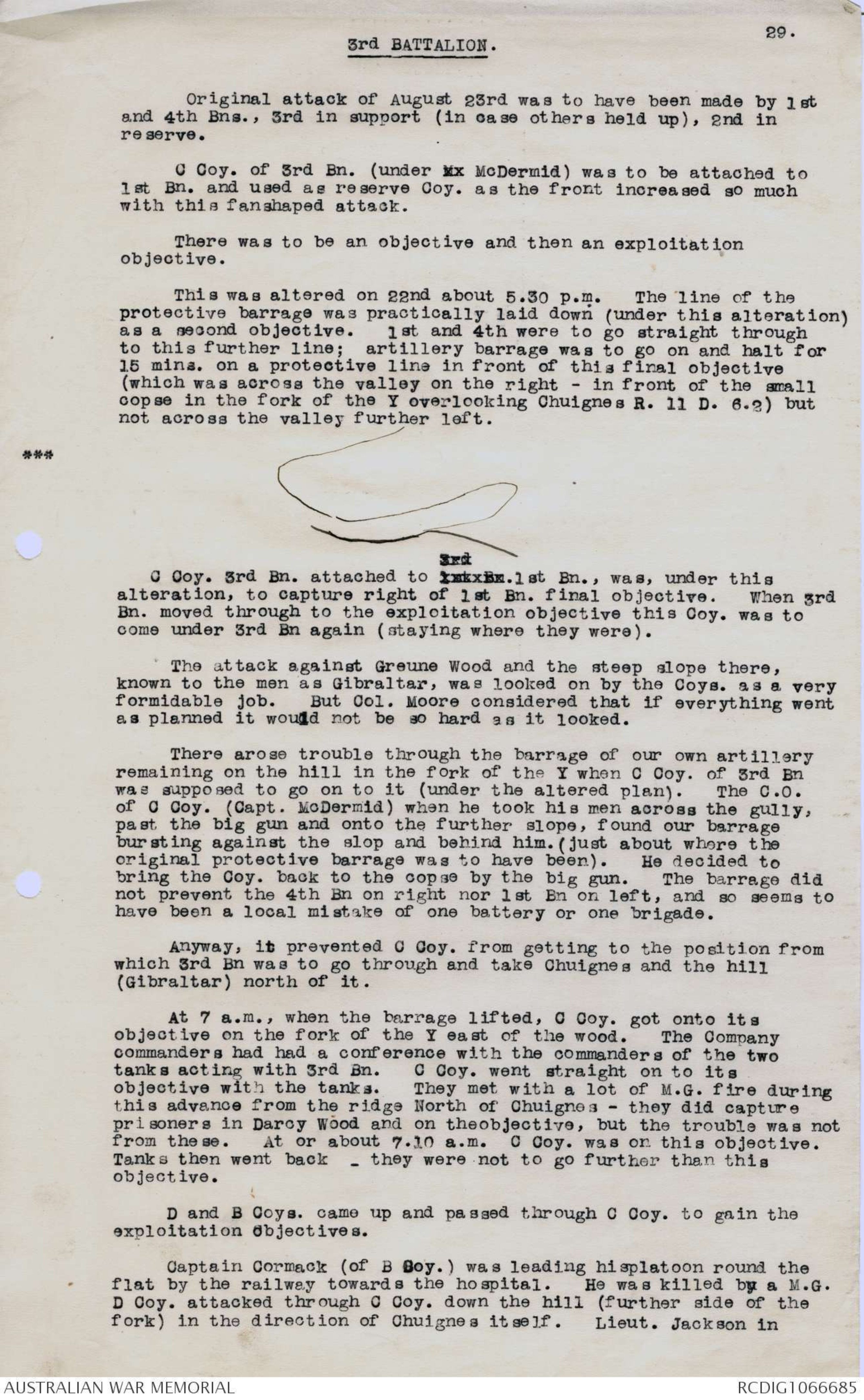
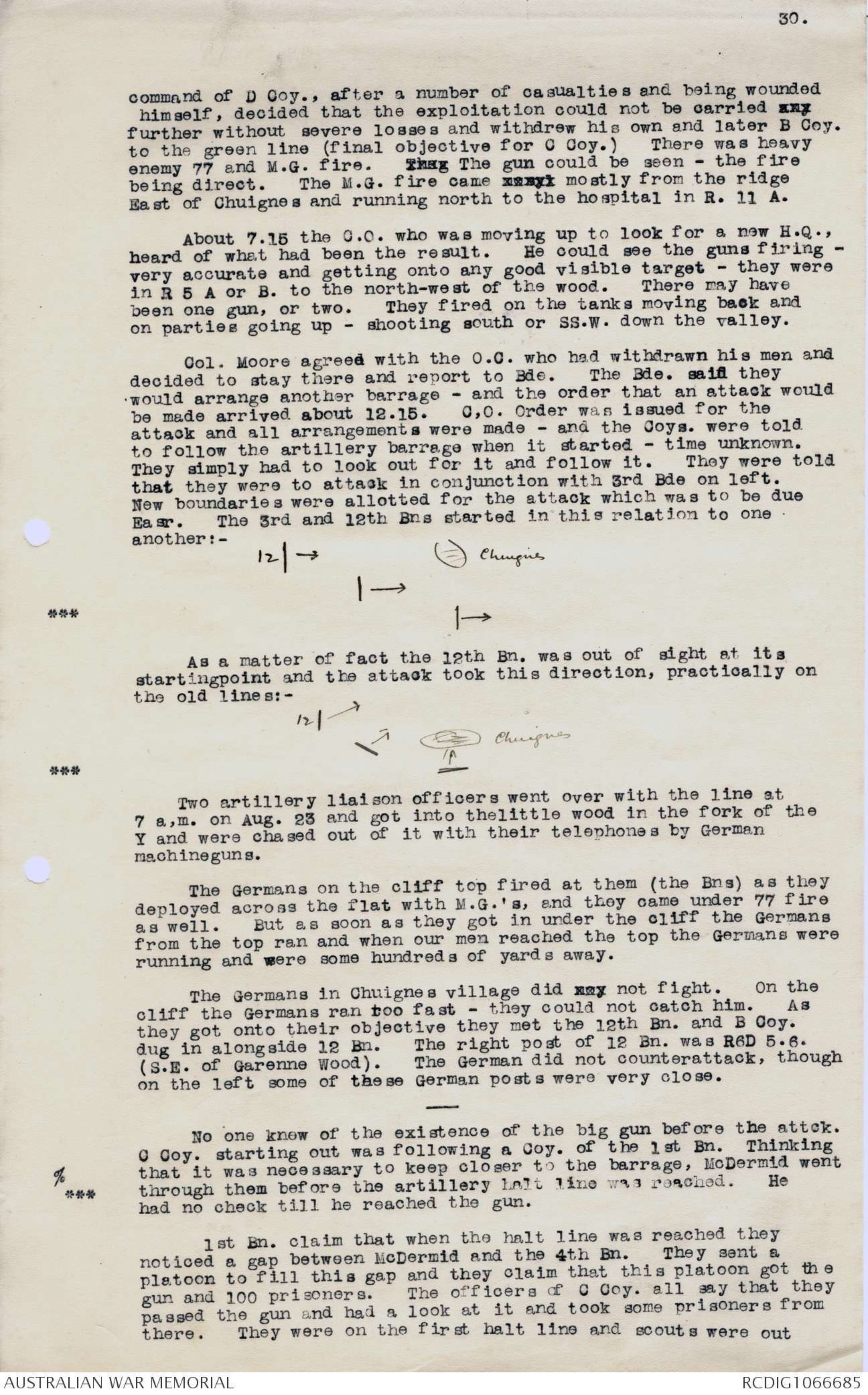
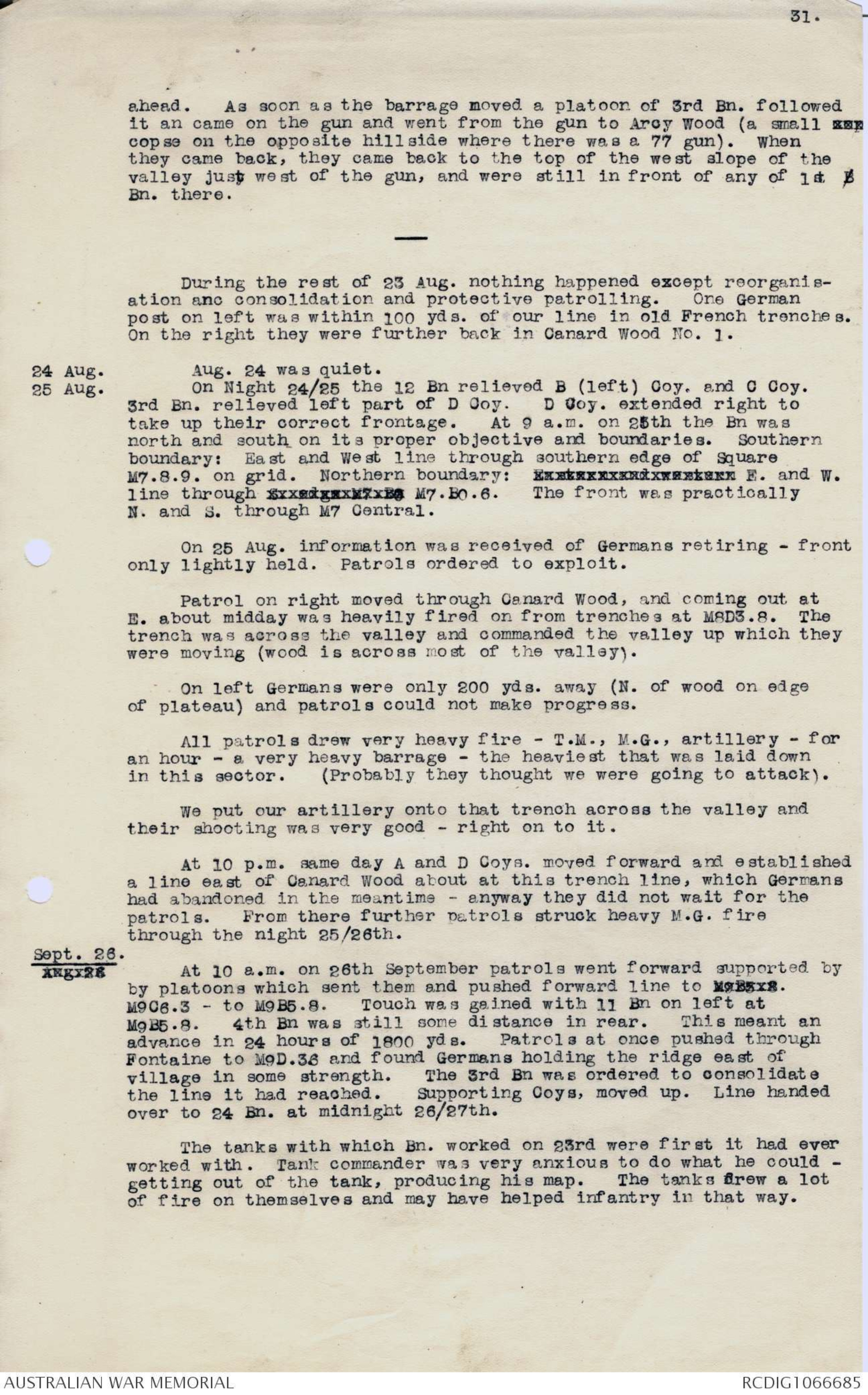
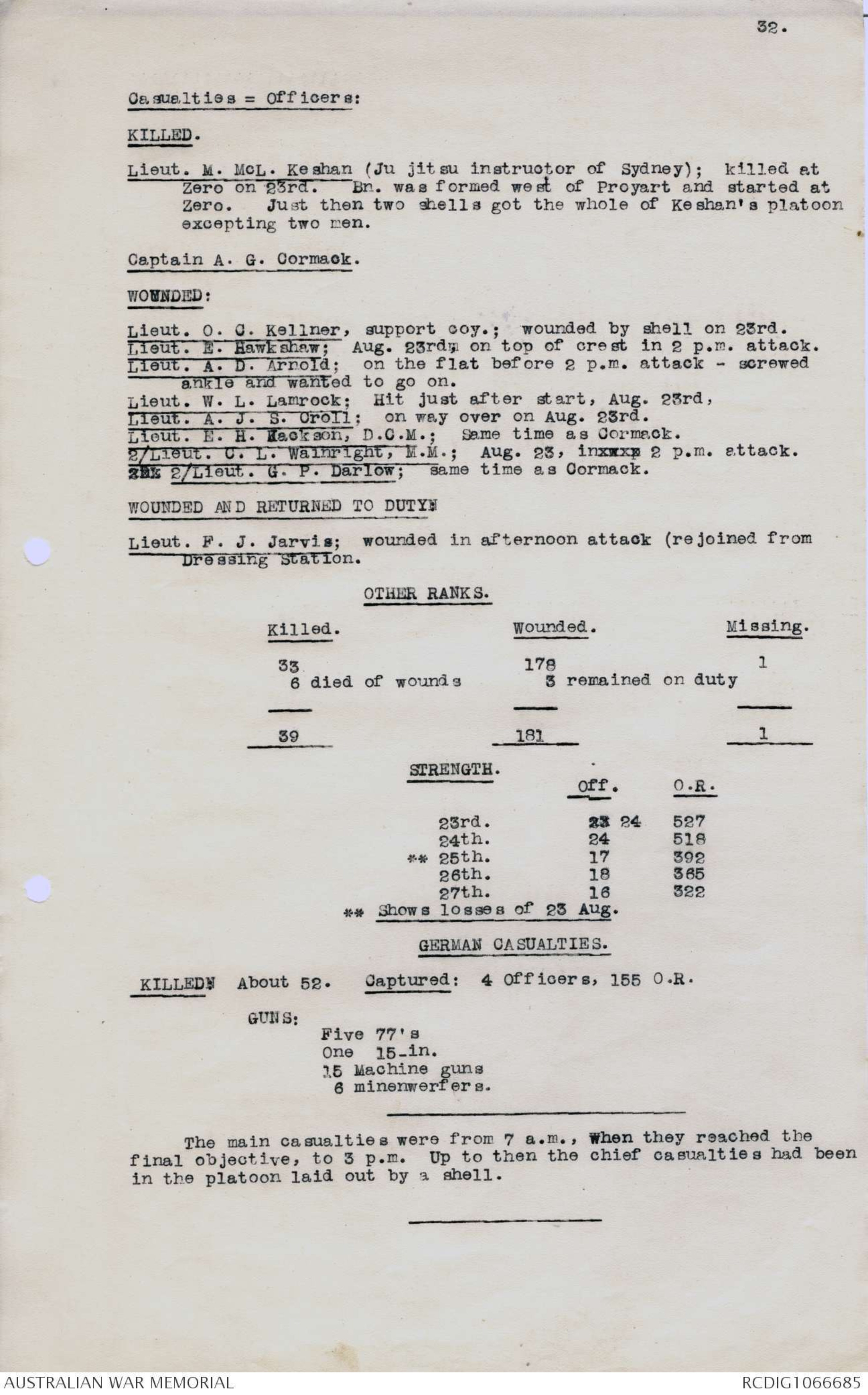
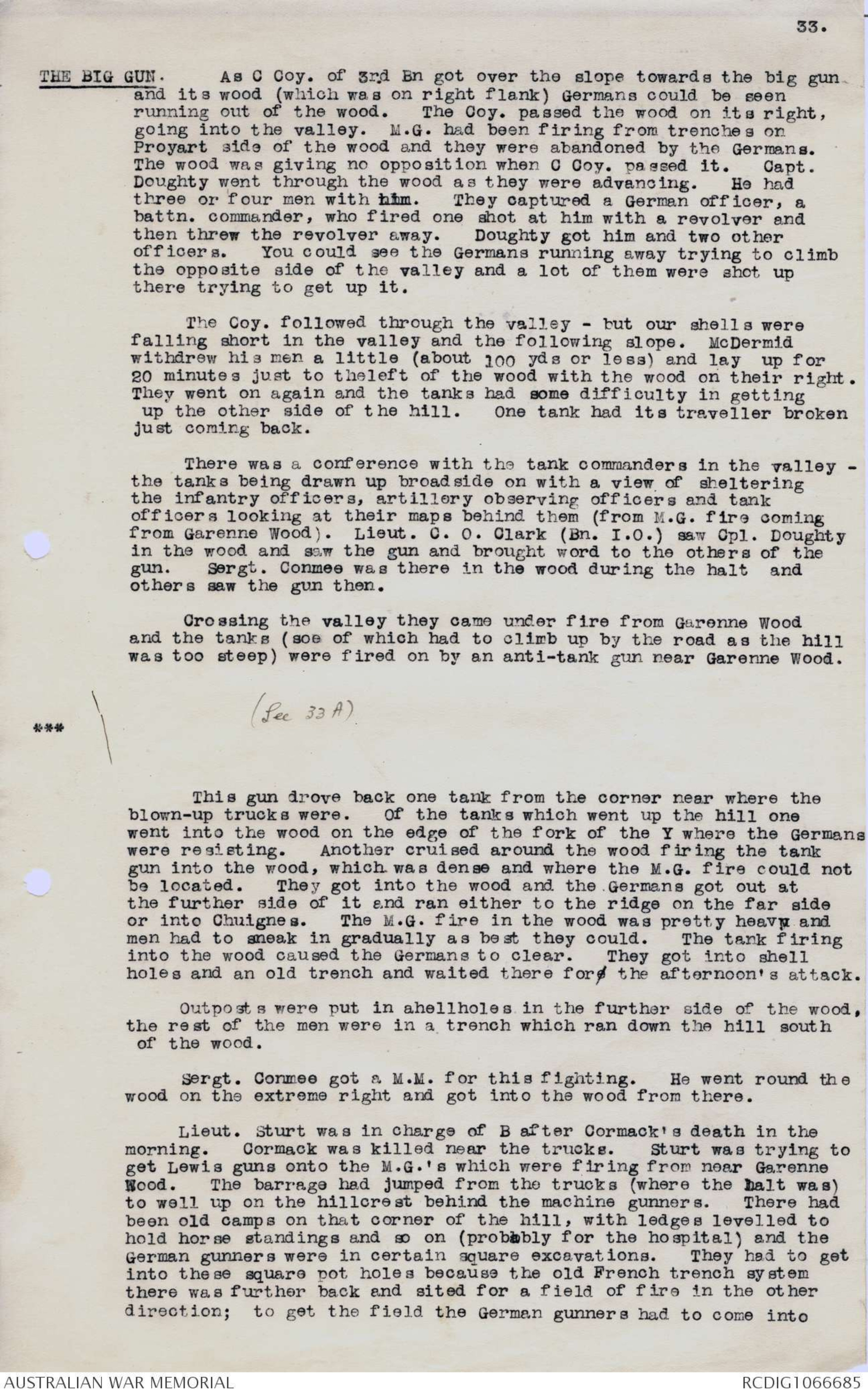
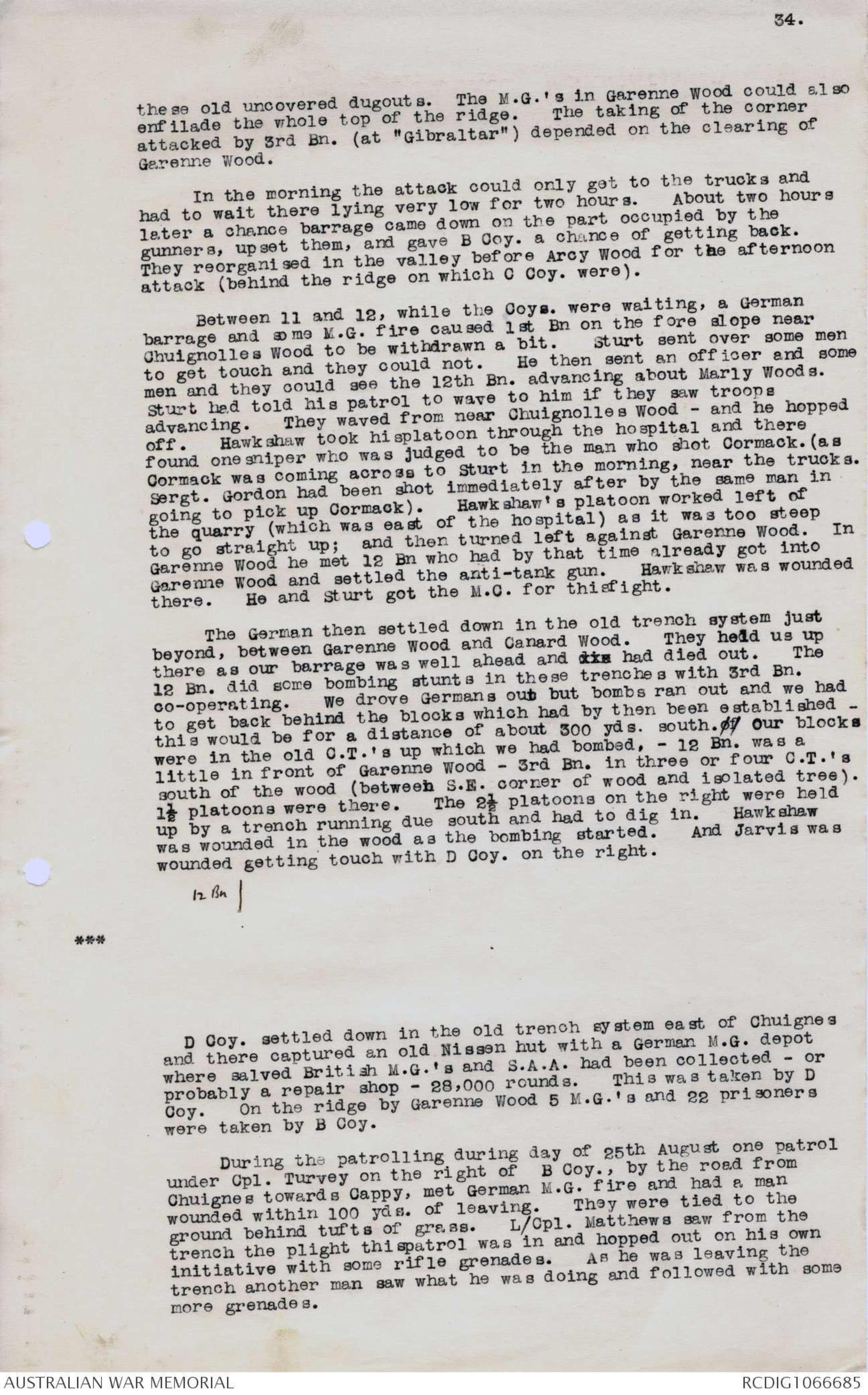
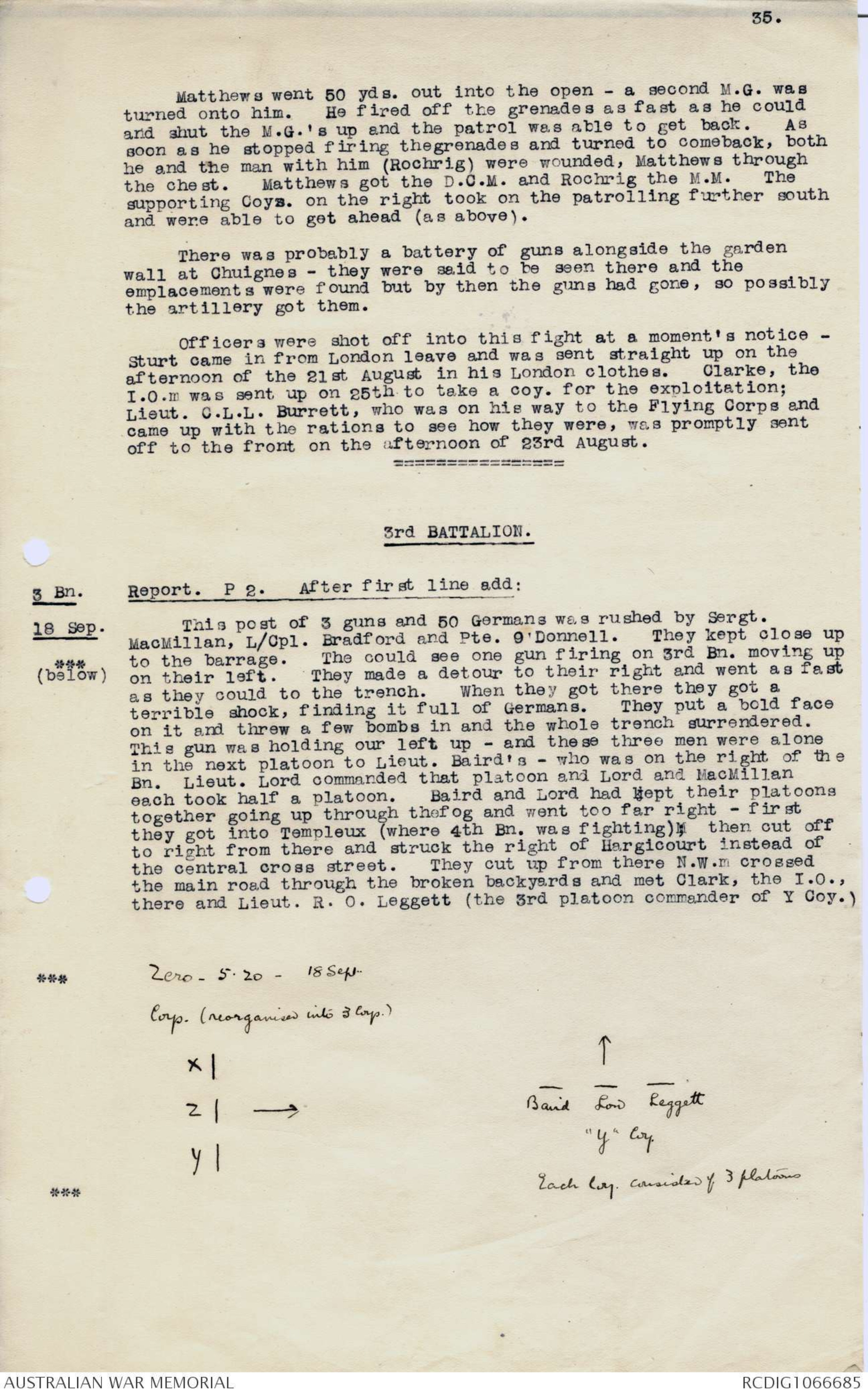
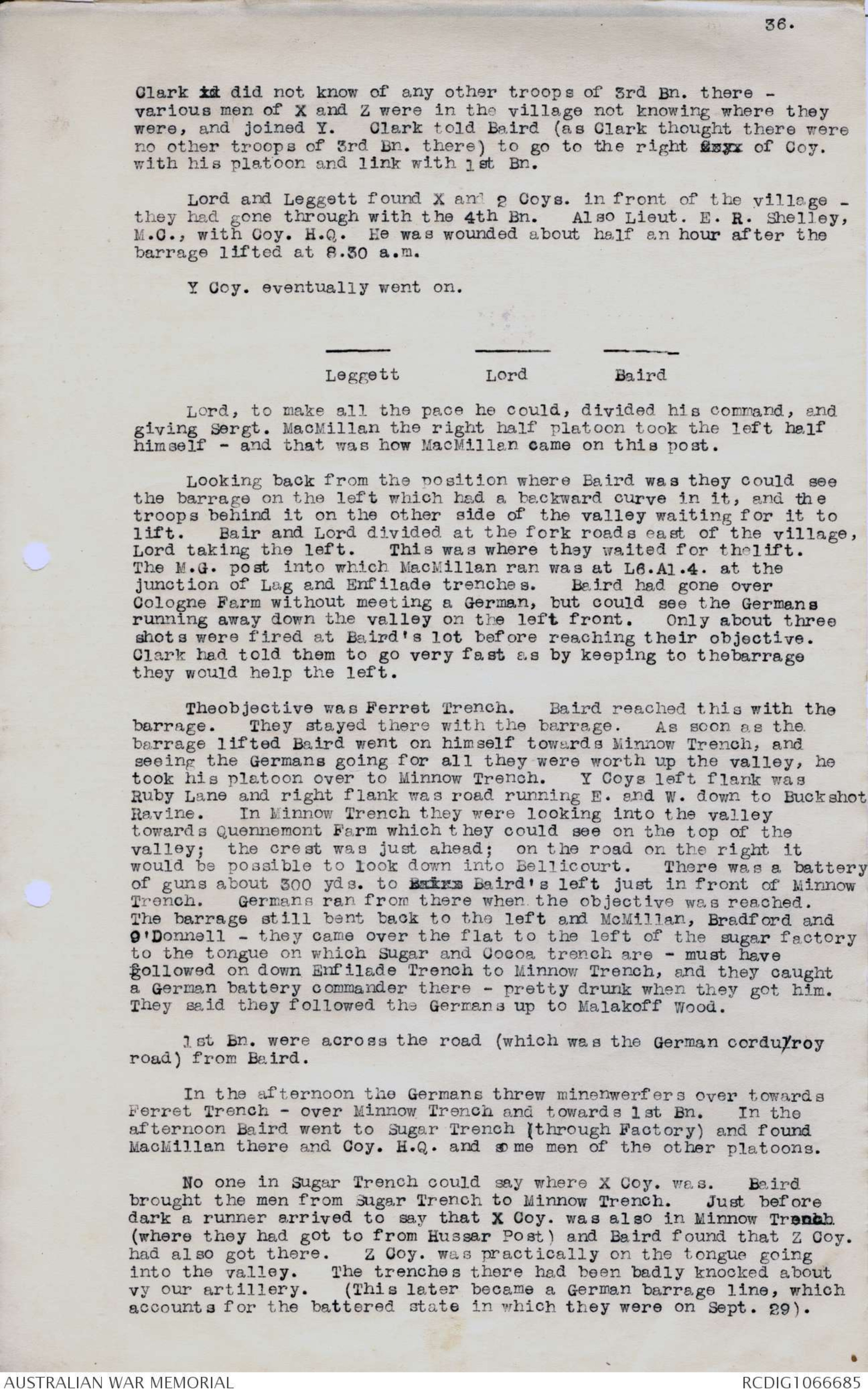
27.
Sept. 18. On night of 17 September 1st M.G. Coy. came in (one section
to each Bn.) - A Section with 1st Bn.
A Section got into position behind the 1st Bn. At Zero hour
they advanced immediately behind the Bn. Trouble did not begin
till German M.G. fire was met from about 10 a 7.3 where there is
a hill - (chalk pit is on the left of it). This was the hill
S.W. of Hargicourt. The infantry worked round the flanks quickly
and got about 50 prisoners out of there.
From there they went without further trouble to the first
halt line. There had been heavy rain and fog, and when the
attack started it was therefore very difficult to see. The rain
was still coming down on the halt line but the fog had raised.
There was trouble met with from the top of Cologne Ridge as the
attack went on up thegully through 12A. This M.G. fire was pretty
heavy, coming from all directions. They were fairly well up with
the barrage. This slowed up the attack a bit. There was no
target for Machineguns. Theguns finished up in position at the
head of Buckshot Ravine, looking down into Bellicourt. They were
in old English trenches here. Further to the left the Germans
counterattacked but not against the Australians.
From our extreme left guns the Germans could be seen in the
afternoon about 5.30 or 6 p.m. It was too far for effective
shooting with the amount of ammunition which they had. They fired
off one box of ammunition and warned the British on their left who
could not see them from their position.
After dark, about 8 or 0 9 p.m. they had to come back. The
Germans had come up along a ridge near Quennemont Farm which could
be seen very well from our position. The Tommies were then
holding the front British line in 25 A and B. The Germans got
behind them and they retired into the trench behind the sunken
road (sunken) through 29 B and D. Thetwo guns of C Section were
brought back at dark at the request of Lieut. Clifton, 3rd Bn. to
fire down this road running towards Ronssoy from about 5B 9.9.
The Germans leaked into Rifle Pit trench.
C Section was kept there till night of 21st September. On
the 21st September the Tommies went forward again (and 3rd and 1st
Bns) over the hill past Malakoff Wood. Theguns fired a barrage
for them from a rear position. One pair of crews were then
relieved for a sleep.
During the days day, about noon, they heard the word all up on
top. TheTommies were all coming back - there were a few shells
but not many. C Section got out and began to get good targets
amongst the Germans coming down the road from Bony at the top of
the valley. The Germans came right back to Rifle trench. They
were back in no time. The Tommies were very scattered and did not
make much of a fightthere. The Germans got in behind them as
before.
C Section on 18th had followed with 3rd Bn (its original
section). They met no opposition till east of Hargicourt. About
600 yds. S.W. of Malakoff Farm, after the barrage lifted, the
German M.G. in the trenches on both sides of the hill made a big
fight. The German guns were about here (also on both sides of
the road through the valley). None of these guns got away. But
the German M.G. fought until we had lost the barrage. Our people
kept stalking the M.G. and got them one by one. No bombing there.
German field guns did not fire direct and their crews were mostly
captured. The country was very open and our attack without
protection.
B Section was with the 2nd Bn on September 18th., and with the
Bn. was held up for a few minutes by M.G. on the ridge East of
Hargicourt. When this was cleared out they went straight on right
28.
of Hargicourt and got some shooting away on the left onto the
Germans retiring along the railway line. They moved up that night
to the 1st Bn. to hold Cologne Ridge.
The Germans shelled this pretty heavily. On the 19th the
Germans counterattacked on the British on the left and two of the
guns fired covering our own flankz. The guns with the 1st Bn.
never had to come back from the position they reached on the day
of 21st.
A Section was in the attack on September 21. From the top
of Buckshot Valley they moved on with the infantry and filled a
gap between the 1st Bn. on left and 6th Bn on right. The strength
was weak and the German M.G. and artillery fire was heavy. They
started from Minnow trench through wood into trench junction
immediately S.E. of wood, facing down Buckshot ravine. xxx 6th Bn
post was further back. 1st Bn. was relieved by 8th Bn. that
night and as another section covered the same ground as A section,
these were withdrawn. That was when they came out of the line.
6th Bn post nearest on right flank was probably xxxxxx at
2 C. 0. 4 (62 C.S.E.)
D Section was with 4th Bn on September 18th. They went over
with the 1st line Coys. of the 4th Bn. and owing to darkness and
smoke barrage put down by the artillery they got hopelessly mixed
up before reaching Templeux. They got too far to the left.
On passing Templeux they lost the infantry and found no one in
front of them. They hit a M.G. post S.E. of the village and put it
out of action. Some of the riflemen fired a few shots into the
trench where the Germans were - and made them keep low - one German
was killed at least, - and advancing took the 7 others prisoner.
They then went on to the railway line where there was a general
forming up.- as the light was better. The attack pushed up into
the Quarries from there, northwards. There were many Germans there
and a good deal of M.G. fire. There was a system of trenches
behind andin front of the quarries. In the quarries we were in
the English sector - they moved further left then.
There was no opposition in Hargicourt village. The infantry
and M.G. started to entrench on the blue line. One gun was on the
extreme left in touch with the Tommies. Our own x8 18-pdrs. were
shooting onto our first objective, shrapnel.
D Section did not move on again till dusk that evening. Then
they moved on and attached themselves to 3rd Bn. Two guns took up
position in Minnow Trench and two in Square = L/B near enfilade
trench.
That night on the English right flank the Germans came out and
took away a battery of guns. It was not where our M.G. could reach
it. They were in NOman'sland just in front of the English north
of Malakoff Wood.
The two guns which went forward were pulled back on night
19/20 into a commanding position in Sugar trench to give support in
depth. Night of 20/21 they went up, two guns into Minnow trench,
two in Cocoa trench. The two guns in Minnow trench went over with
3rd Bn at 6.30 on Sept. 21st. There was no opposition on the way
over. The German barrage fell on Nomansland here, but on Minnow
trench further south. There was oneman hit in the leg going over
by a shell. Later - about 10 a.m. a shell landed on the edge of the
post which had been dug - blew out he tripod and wounded two men.
Shortly after, owing to the people on theleft (British - Buffs)
falling back, our flank was exposed and we had to fall back also
under very heavy M.G. fire. They had gone out about 600 yds. to
the N. sideof Buckshot Ravine and had to fall back to Minnow xxxx
trench and took up again a defensive position.
That night they were relieved and came back to Hervilly.
29.
3rd BATTALION.
Original attack of August 23rd was to have been made by 1st
and 4th Bns., 3rd in support (in case others held up), and in
reserve.
C Coy. of 3rd Bn. (under xx McDermid) was to be attached to
1st Bn. and used as reserve Coy. as the front increased so much
with this fanshaped attack.
There was to be an objective and then an exploitation
objective.
This was altered on 22nd about 5.30 p.m. The line of the
protective barrage was practically laid down (under this alteration)
as a second objective. 1st and 4th were to go straight through
to this further line; artillery barrage was to go on and halt for
15 mins. on a protective line in front of this final objective
(which was across the valley on the right - in front of the small
copse in the fork of the Y overlooking Chuignes R. 11 D. 6.2) but
not across the valley further left.
Hand drawn diagram - see original document
C Coy. 3rd Bn. attached to 3rd xxxxxx 1st Bn., was, under this
alteration, to capture right of 1st Bn. final objective. When 3rd
Bn. moved through to the exploitation objective this Coy. was to
come under 3rd Bn again (staying where they were).
The attack against Greune Wood and the steep slope there,
known to the men as Gibraltar, was looked on by the Coys. as a very
formidable job. But Col. Moore considered that if everything went
as planned it would not be so hard as it looked.
There arose trouble through the barrage of our own artillery
remaining on the hill in the fork of the Y when C Coy. of 3rd Bn
was supposed to go on to it (under the altered plan). The C.O.
of C Coy. (Capt. McDermid) when he took his men across the gully,
past the big gun and onto the further slope, found our barrage
bursting against the slop and behind him. (just about where the
original protective barrage was to have been). He decided to
bring the Coy. back to the copse by the big gun. The barrage did
not prevent the 4th Bn on right nor 1st Bn on left, and so seems to
have been a local mistake of one battery or one brigade.
Anyway, it prevented C Coy. from getting to the position from
which 3rd Bn was to go through and take Chuignes and the hill
(Gibraltar) north of it.
At 7 a.m., when the barrage lifted, C Coy. got onto its
objective on the fork of the Y east of the wood. The Company
commanders had had a conference with the commanders of the two
tanks acting with 3rd Bn. C Coy. went straight on to its
objective with the tanks. They met with a lot of M.G. fire during
this advance from the ridge North of Chuignes - they did capture
prisoners in Darcy Wood and on theobjective, but the trouble was not
from these. At or about 7.10 a.m. C Coy. was on this objective.
Tanks then went back - they were not to go further than this
objective.
D and B Coys. came up and passed through C Coy. to gain the
exploitation objectives.
Captain Cormack (of B Coy.) was leading hisplatoon round the
flat by the railway towards the hospital. He was killed by a M.G.
D Coy. attacked through C Coy, down the hill (further side of the
fork) in the direction of Chuignes itself. Lieut. Jackson in
30.
command of D Coy., after a number of casualties and being wounded
himself, decided that the exploitation could not be carried xxx
further without severe losses and withdrew his own and later B Coy.
to the green line (final objective for C Coy. There was heavy
enemy 77 and M.G. fire. xxxxx The gun could be seen - the fire
being direct. The M.G. fire came xxxxx mostly from the ridge
East of Chuignes and running north to the hospital in R. 11 A.
About 7.15 the C.O. who was moving up to look for a new H.Q.,
heard of what had been the result. He could see the guns firing
very accurate and getting onto any good visible target - they were
in R 5 A or B. to the north-west of the wood. There may have
been one gun, or two. They fired on the tanks moving back and
on parties going up - shooting south or SS.W. down the valley.
Col. Moore agreed with the O.C. who had withdrawn his men and
decided to stay there and report to Bde. The Bde. said they
would arrange another barrage - and the order that an attack would
be made arrived about 12.15. C,O. Order was issued for the
attack and all arrangements were made - and the Coys, were told
to follow the artillery barrage when it started - time unknown.
They simply had to look out for it and follow it. They were told
that they were to attack in conjunction with 3rd Bde on left.
New boundaries were allotted for the attack which was to be due
Easr. The 3rd and 12t Bns started in'this relation to one
another
Diagram - see original document
As a matter of fact the 12th Bn, was out of sight at its
startingpoint and the attack took this direction, practically on
the old lines:-
Diagram - see original document
Two artillery liaison officers went over with the line at
7 a.m. on Aug. 23 and got into thelittle wood in the fork of the
Y and were chased out of it with their telephones by German
machineguns.
The Germans on the cliff top fired at them (the Bns) as they
deployed across the flat with M.G.'s, and they came under 77 fire
as well. But as soon as they got in under the cliff the Germans
from the top ran and when our men reached the top the Germans were
running and were some hundreds of yards away.
The Germans in Chuignes village did xxx not fight. On the
cliff the Germans ran too fast - they could not catch him. As
they got onto their objective they met the 12th Bn. and B Coy.
dug in alongside 12 Bn. The right post of 12 Bn. was R6D 5.8.
(S.E. of Garenne Wood). The German did not counterattack, though
on the left some of these German posts were very close.
No one know of the existence of the big gun before the attck.
C Coy, starting out was following a Coy, of the 1st Bn. Thinking
that it was necessary to keep closer to the barrage, McDermid went
through them before the artillery halt line was reached. He
had no check till he reached the gun.
1st Bn. claim that when the halt line was reached they
noticed a gap between McDermid and the 4th Bn. They sent a
platoon to fill this gap and they claim that this platoon got the
gun and 100 prisoners. The officers of C Coy. all say that they
passed the gun and had a look at it and took some prisoners from
there. They were on the first halt line and scouts were out
31.
ahead. As soon as the barrage moved a platoon of 3rd Bn. followed
it an came on the gun and went from the gun to Arcy Wood (a small xxxxx
copse on the opposite hillside where there was a 77 gun). When
they came back, they came back to the top of the west slope of the
valley just west of the gun, and were still in front of any of 1st B
Bn. there.
During the rest of 23 Aug. nothing happened except reorganisation
and consolidation and protective patrolling. One German
post on left was within 100 yds. of our line in old French trenches.
On the right they were further back in Canard Wood No. 1.
24 Aug. Aug. 24 was quiet.
25 Aug. On Night 24/25 the 12 Bn relieved B (left) Coy. and C Coy.
3rd Bn. relieved left part of D Coy. D Coy. extended right to
take up their correct frontage. At 9 a.m. on 25th the Bn was
north and south on its proper objective and boundaries. Southern
boundary: East and West line through southern edge of Square
M7.8.9. on grid. Northern boundary: . xxxxxxxxxxxxxxxxxxx E. and W
line through M7.B0.8. The front was practically
N. and S. through M7 Central.
On 25 Aug. information was received of Germans retiring - front
only lightly held. Patrols ordered to exploit.
Patrol on right moved through Canard Wood, and coming out at
E. about midday was heavily fired on from trenches at M8D3.8. The
trench was across the valley and commanded the valley up which they
were moving (wood is across most of the valley).
On left Germans were only 200 yds. away (N. of wood on edge
of plateau) and patrols could not make progress.
All patrols drew very heavy fire - T.M., M.G., artillery - for
an hour - a very heavy barrage - the heaviest that was laid down
in this sector. (Probably they thought we were going to attack).
We put our artillery onto that trench across the valley and
their shooting was very good - right on to it.
At 10 p.m. same day A and D Coys, moved forward and established
a line east of Canard Wood about at this trench line, which Germans
had abandoned in the meantime - anyway they did not wait for the
patrols. From there further patrols struck heavy M.G. fire
through the night 25/28th.
Sept 26 xxxxx At 10 a.m. on 26th September patrols went forward supported by
by platoons which sent them and pushed forward line to xxxxx
M9C6.3 - to M9B5.8. Touch was gained with 11 Bn on left at
M9B5.8. 4th Bn was still some distance in rear. This meant an
advance in 24 hours of 1800yds. Patrols at once pushed through
Fontaine to M9D.36 and found Germans holding the ridge east of
village in some strength. The 3rd Bn was ordered to consolidate
the line it had reached. Supporting Coys, moved up. Line handed
over to 24 Bn. at midnight 26/27th.
The tanks with which Bn. worked on 23rd were first it had ever
worked with. Tank commander was very anxious to do what he could-
getting out of the tank, producing his map. The tanks drew a lot
of fire on themselves and may have helped infantry in that way.
32.
Casualties - Officers:
KILLED.
Lieut. M. McL. Keshan (Ju jitsu instruotor of Sydney); killed at
Zero on 23rd. Bn. was formed west of Proyart and started at
Zero. Just then two shells got the whole of Keshan's platoon
excepting two men.
Captain A. G. Cormack.
WOUNDED:
Lieut. O. C. Kellner, support coy.; wounded by shell on 23rd.
Lieut. E. Hawkshaw; Aug. 23rdm on top of crest in 2 p.m. attack.
Lieut. A. D. Arnold; on the flat before 2 p.m. attack - screwed
ankle and wanted to go on.
Lieut. W. L. Lamrock; Hit just after start, Aug. 23rd,
Lieut. A. J. S. Croll; on way over on Aug. 23rd.
Lieut. E. H. Jackson, D.C.M.; Same time as Cormack.
2/Lieut. C. L. Walnright, M.M.; Aug. 23, inxxxx 2 p.m. attack.xxx 2/Lieut. G. P. Darlow; Same time as Cormack.
WOUNDED AND RETURNED TO DUTY:
Lieut. F. J. Jarvis; wounded in afternoon attack (rejoined from
Dressing Station.
OTHER RANKS.
Killed. Wounded. Missing.
33 178 1
6 died of wounds 3 remained on duty
39 181 1
STRENGTH
Off. O.R.
23rd. 2324 527
24th. 24 518
**25th. 17 392
26th 18 365
27th 16 322
**Shows losses of 23 Aug.
GERMAN CASUALTIES.
KILLED: About 52. Captured: 4 Officers, 155 O.R.
GUNS:
Five 77's
One 15-in.
15 Machine guns
6 minenwerfers.
The main casualties were from 7 a.m., When they reached the
final objective, to 3 p.m. Up to then the chief casualties had been
in the platoon laid out by a shell.
33.
THE BIG GUN.
As C Coy. of 3rd Bn got over the slope towards the big gun.
and its wood (which was on right flank) Germans could be seen
running out of the wood. The Coy. passed the wood on its right,
going into the valley. M.G. had been firing from trenches on
Proyart side of the wood and they were abandoned by the Germans.
The wood was giving no opposition when C Coy. passed it. Capt.
Doughty went through the wood as they were advancing. He had
three or four men with him. They captured a German officer, a
battn. commander, who fired one shot at him with a revolver and
then threw the revolver away. Doughty got him and two other
officers. You could see the Germans running away trying to climb
the opposite side of the valley and a lot of them were shot up
there trying to get up it.
The Coy. followed through the valley - but our shells were
falling short in the valley and the following slope. McDermid
withdrew his men a little (about 100 yds or less) and lay up for
20 minutes just to theleft of the wood with the wood on their right.
They went on again and the tanks had some difficulty in getting
up the other side of the hill. One tank had its traveller broken
just coming back.
There was a conference with the tank commanders in the valley -
the tanks being drawn up broadside on with a view of sheltering
the infantry officers, artillery observing officers and tank
officers looking at their maps behind them (from M.G. fire coming
from Garenne Wood). Lieut. C. O. Clark (Bn. I.O.) saw Cpl. Doughty
in the wood and saw the gun and brought word to the others of the
gun. Sergt. Conmee was there in the wood during the halt and
others saw the gun then.
Crossing the valley they came under fire from Garenne Wood
and the tanks (soe of which had to climb up by the road as the hill
was too steep) were fired on by an anti-tank gun near Garenne Wood.
(See 33A)
This gun drove back one tank from the corner near where the
blown-up trucks were. Of the tanks which went up the hill one
went into the wood on the edge of the fork of the Y where the Germans
were resisting. Another cruised around the wood firing the tank
gun into the wood, which was dense and where the M.G. fire could not
be located. They got into the wood and the Germans got out at
the further side of it and ran either to the ridge on the far side
or into Chuignes. The M.G. fire in the wood was pretty heavy and
men had to sneak in gradually as best they could. The tank firing
into the wood caused the Germans to clear. They got into shell
holes and an old trench and waited there fore the afternoon's attack.
Outposts were put in ahellholes in the further side of the wood,
the rest of the men were in a trench which ran down the hill south
of the wood.
Sergt. Conmee got a M.M. for this fighting. He went round the
wood on the extreme right and got into the wood from there.
Lieut. Sturt was in charge of B after Cormack's death in the
morning. Cormack was killed near the trucks. Sturt was trying to
get Lewis guns onto the M.G.'s which were firing from near Garenne
Nood. The barrage had jumped from the trucks (where the halt was)
to well up on the hillcrest behind the machine gunners. There had
been old camps on that corner of the hill, with ledges levelled to
hold horse standings and so on (probably for the hospital) and the
German gunners were in certain square excavations. They had to get
into these square pot holes because the old French trench system
there was further back and sited for a field of fire in the other
direction; to get the field the German gunners had to come into
34.
these old uncovered dugouts. The M.G.'s in Garenne Wood could also
enfilade the whole top of the ridge. The taking of the corner
attacked by 3rd Bn. (at "Gibraltar") depended on the clearing of
Garenne Wood.
In the morning the attack could only get to the trucks and
had to wait there lying very low for two hours. About two hours
later a chance barrage came down on the part occupied by the
gunners, upset them, and gave B Coy. a chance of getting back.
They reorganised in the valley before Arcy Wood for the afternoon
attack (behind the ridge on which C Coy. were).
Between 11 and 12, while the Coys, were waiting, a German
barrage and some M.G. fire caused 1st Bn on the fore slope near
Chuignolles Wood to be withdrawn a bit. Sturt sent over some men
to get touch and they could not. He then sent an officer and some
men and they could see the 12th Bn. advancing about Marly Woods.
Sturt had told his patrol to wave to him if they saw troops
advancing. They waved from near Chuignolles Wood - and he hopped
off. Hawkshaw took hisplatoon through the hospital and there
found onesniper who was judged to be the man who shot Cormack. (as
Cormack was coming across to Sturt in the morning, near the trucks.
Sergt. Gordon had been shot immediately after by the same man in
going to pick up Cormack). Hawkshaw's platoon worked left of
the quarry (which was east of the hospital) as it was too steep
to go straight up; and then turned left against Garenne Wood. In
Garenne Wood he met 12 Bn who had by that time already got into
Garenne Wood and settled the anti-tank gun. Hawkshaw was wounded
there. He and Sturt got the M.C. for thisfight.
The German then settled down in the old trench system just
beyond, between Garenne Wood and Canard Wood. They held us up
there as our barrage was well ahead and xxx had died out. The
12 Bn. did some bombing stunts in these trenches with 3rd Bn.
co-operating. We drove Germans out but bombs ran out and we had
to get back behind the blocks which had by then been established -
this would be for a distance of about 300 yds. south of Our blocks
were in the old C.T.'s up which we had bombed, - 12 Bn. was a
little in front of Garenne Wood - 3rd Bn. in three or four C.T.'s
south of the wood (between S.E. corner of wood and isolated tree).
1½ platoons were there. The 2½ platoons on the right were held
up by a trench running due south and had to dig in. Hawkshaw
was wounded in the wood as the bombing started. And Jarvis was
wounded getting touch with D Coy. on the right.
12 Bn|
D Coy, settled down in the old trench system east of Chuignes
and there captured an old Nissen hut with a German M.G. depot
where salved British M.G.'s and S.A.A. had been collected - or
probably a repair shop - 28,000 rounds. This was taken by D
Coy. On the ridge by Garenne Wood 5 M.G.'s and 22 prisoners
were taken by B Coy.
During the patrolling during day of 25th August one patrol
under Cpl. Turvey on the right of B Coy., by the road from
Chuignes towards Cappy, met German M.G. fire and had a man
wounded within 100 yds. of leaving. They were tied to the
ground behind tufts of grass. L/Cpl. Matthews saw from the
trench the plight thispatrol was in and hopped out on his own
initiative with some rifle grenades. As he was leaving the
trench another man saw what he was doing and followed with some
more grenades.
35.
Matthews went 50 yds. out into the open - a second M.G. was
turned onto him. He fired off the grenades as fast as he could
and shut the M.G.'s up and the patrol was able to get back. As
soon as he stopped firing thegrenades and turned to comeback, both
he and the man with him (Rochrig) were wounded, Matthews through
the chest. Matthews got the D.C.M. and Rochrig the M.M. The
supporting Coys. on the right took on the patrolling further south
and were able to get ahead (as above).
There was probably a battery of guns alongside the garden
wall at Chuignes - they were said to be seen there and the
emplacements were found but by then the guns had gone, so possibly
the artillery got them.
Officers were shot off into this fight at a moment's notice -
Sturt came in from London leave and was sent straight up on the
afternoon of the 21st August in his London clothes. Clarke, the
I.O.m was sent up on 25th to take a coy. for the exploitation;
Lieut. C.L.L. Burrett, who was on his way to the Flying Corps and
came up with the rations to see how they were, was promptly sent
off to the front on the afternoon of 23rd August.
3rd BATTALION.
3 Bn. Report. P2. After first line add:
18 Sep. This post of 3 guns and 50 Germans was rushed by Sergt.
MacMillan, L/Cpl. Bradford and Pte. O'Donnell. They kept close up
*** (below) to the barrage. The could see one gun firing on 3rd Bn. moving up
on their left. They made a detour to their right and went as fast
as they could to the trench. When they got there they got a
terrible shock, finding it full of Germans. They put a bold face
on it and threw a few bombs in and the whole trench surrendered.
This gun was holding our left up - and these three men were alone
in the next platoon to Lieut. Baird's - who was on the right of the
Bn. Lieut. Lord commanded that platoon and Lord and MacMillan
each took half a platoon. Baird and Lord had kept their platoons
together going up through thefog and went too far right - first
they got into Templeux (where 4th Bn. was fighting) then cut off
to right from there and struck the right of Hargicourt instead of
the central cross street. They cut up from there N.W.m crossed
the main road through the broken backyards and met Clark, the I.O.,
there and Lieut. R. O. Leggett (the 3rd platoon commander of Y Coy.
Diagram - see original document
36.
Clark xx did not know of any other troops of 3rd Bn. there -
various men of X and Z were in the village not knowing where they
were, and joined Y. Clark told Baird (as Clark thought there were
no other troops of 3rd Bn. there) to go to the right xxxx of Coy.
with his platoon and link with 1st Bn.
Lord and Leggett found X and 2 Coys. in front of the village -
they had gone through with the 4th Bn. Also Lieut. E. R. Shelley,
M.C., with Coy. H.Q. He was wounded about half an hour after the
barrage lifted at 8.30 a.m.
Y Coy. eventually went on.
Diagram - see original document
Lord, to make all the pace he could, divided his command, and
giving Sergt. MacMillan the right half platoon took the left half
himself - and that was how MacMillan came on this post.
Looking back from the position where Baird was they could see
the barrage on the left which had a backward curve in it, and the
troops behind it on the other side of the valley waiting for it to
lift. Bair and Lord divided at the fork roads east of the village,
Lord taking the left. This was where they waited for thelift.
The M.G. post into which MacMillan ran was at L8.A1.4. at the
junction of Lag and Enfilade trenches. Baird had gone over
Cologne Farm without meeting a German, but could see the Germans
running away down the valley on the left front. Only about three
shots were fired at Baird's lot before reaching their objective.
Clark had told them to go very fast as by keeping to thebarrage
they would help the left.
Theobjective was Ferret Trench. Baird reached this with the
barrage. They stayed there with the barrage. As soon as the
barrage lifted Baird went on himself towards Minnow Trench, and
seeing the Germans going for all they were worth up the valley, he
took his platoon over to Minnow Trench. Y Coys left flank was
Ruby Lane and right flank was road running E. and W. down to Buckshot
Ravine. In Minnow Trench they were looking into the valley
towards Quennemont Farm which they could see on the top of the
valley; the crest was just ahead; on the road on the right it
would be possible to look down into Bellicourt. There was a battery
of guns about 300 yds. to xxxxx Baird's left just in front of Minnow
Trench. Germans ran from there when the objective was reached.
The barrage still bent back to the left and McMillan, Bradford and
O'Donnell - they came over the flat to the left of the sugar factory
to the tongue on which Sugar and Cocoa trench are - must have
followed on down Enfilade Trench to Minnow Trench, and they caught
a German battery commander there - pretty drunk when they got him.
They said they followed the Germans up to Malakoff Wood.
1st Bn. were across the road (which was the German cordulroy
road) from Baird.
In the afternoon the Germans threw minenwerfers over towards
Ferret Trench - over Minnow Trench and towards 1st Bn. In the
afternoon Baird went to Sugar Trench [through Factory) and found
MacMillan there and Coy. H.Q. and some men of the other platoons.
No one in sugar Trench could say where X Coy, was. Baird
brought the men from Sugar Trench to Minnow Trench. Just before
dark a runner arrived to say that X Coy, was also in Minnow Trench
(where they had got to from Hussar Post) and Baird found that Z Coy.
had also got there. Z Coy, was practically on the tongue going
into the valley. The trenches there had been badly knocked about
vy our artillery. (This later became a German barrage line, which
accounts for the battered state in which they were on Sept. 29).
 Maralyn K
Maralyn KThis transcription item is now locked to you for editing. To release the lock either Save your changes or Cancel.
This lock will be automatically released after 60 minutes of inactivity.